AMD Phenom II X4 965 Black Edition: The Peak of Deneb Evolution

With the launch of their new processor AMD set a new frequency record for desktop platforms: Phenom II X4 965 Black Edition works at 3.4 GHz. What is it: an attempt to return to the high-end segment or a preemptive strike in the light of upcoming Intel Lynnfield? Let’s try finding an answer to this question.
The introduction of 45 nm manufacturing process turned things around for AMD and fortune started to smile upon them again. New processor cores that were used for Phenom II and Athlon II CPUs allowed AMD to significantly increase the cache memory size and clock frequencies. These improvements were enough to make the new AMD offerings make a successful comeback into the mainstream segment. At this time the price-to-performance ratio offered by AMD processors on 45 nm cores is attractive enough for them to compete successfully against most Intel solutions. Of course, AMD hasn’t yet managed to become a threat for Intel in the upper price segment, but even despite this fact, Phenom II and Athlon II processors are a definite success: the growing consumer interest to these solutions is a clear indication of that.
However, AMD’s immediate future doesn’t look too rosy. Intel has long been preparing a significant refresh of their solutions lineup in $200+ price range. The long awaited Intel Lynnfield processors and new LGA1156 platform that should start selling some time in September have every chance to become extremely interesting offerings and attract a lot of attention. And even though most Phenom II processors are priced a little lower, which saves them from the need to compete directly against LGA1156 newcomers, AMD shows signs of concern about this whole situation. Despite their initial plans, the company is working really hard on increasing the clock speeds of their high-end processor models even despite extremely increased heat dissipation. Following Phenom II X4 955 working at 3.2 GHz clock speed, AMD decided to announce an even faster model – Phenom II X4 965 supporting 3.4 GHz clock frequency at 140 W typical heat dissipation, which is 15 W higher than the TDP of all other solutions in this family. We are going to find out a little later if t this sacrifice is worth it and if the new Phenom II X4 965 will be able to stand even against the junior Lynnfield solution. Today, however, we are going to introduce the newcomer to you and see how well it performs against the already selling processors.
It is important to point out that by launching the new Phenom II X4 965 the manufacturer doesn’t raise the price bar any higher: the new CPU will sell at the same exact official price as its predecessor – $245. Moreover, due to close partnership with other components manufacturers AMD managed to arrange very attractive discounts on kits including new CPUs, mainboards and maybe memory and graphics card, too. In some cases the discounts may reach up to $40 (this will most likely occur only in the US market, though). So, AMD is not really trying to conquer higher-end market: the company is only attempting to compete against Intel Core 2 Quad and if they are lucky – the upcoming Core i5.
Closer Look at the New Phenom II X4 965 Black Edition CPU
This time our story of the new processor will be pretty short. Phenom II X4 965 is based on exactly the same semiconductor Deneb core as other Socket AM3 Phenom II X4 processors. In other words, Phenom II X4 965 is the result of simple increase in the clock speed to 3.4 GHz. In fact, it is a pretty logical solution. As we have seen from our previous overclocking tests, contemporary 45 nm quad-core AMD processors can work perfectly fine at frequencies up to 3.6-3.8 GHz with air-cooling alone. That is why it is not surprising at all that AMD decided to strengthen their position in the CPU market by simply increasing the clock frequency by another 200 MHz increment.
There is only one thing: this time clock frequency increase wasn’t really free: it led to increase in Phenom II X4 965 heat dissipation beyond the initially set Socket AM3 processors TDP of 125 W. The new CPU has a TDP of 140 W. However, the processor voltage regulator circuitry on most Socket AM3 mainboards can deal with this load just fine.
After everything we have just said, the specifications of the new Phenom II X4 965 processor look quite logical:
Just like all previous top Phenom II X4 processor models, the new solution also belongs to the Black Edition series. It means that the CPU has an unlocked clock frequency multiplier that makes overclocking experiments way easier to perform.
Looks like Phenom II X4 965 is the last addition to the “top” of the Phenom II X4 family. Increased heat dissipation and proximity to exhausting the overclocking potential suggest that it won’t be soon before AMD increases the clock speed of their CPUs again. There is only one thing they can do to increase the performance of their solution without changing anything in the microarchitecture or releasing new Deneb processor stepping: they can increase the working frequency of the North Bridge part built into the CPU or support of faster memory, especially since Phenom II X4 processor can already work with DDR3-1600, though unofficially. However, I don’t think you should really bet on these improvements, as they will have minimal effect on the overall performance.
Testbed and Methods
We tested the new Phenom II X4 965 processor together with the previous top model from the same family – Phenom II X4 955. These two AMD solutions will be competing against two CPUs from Intel. The first one is Core 2 Quad Q9550, which is the closest alternative in terms of price. The second one is Core i7-920, which is a little more expensive than the top AMD processors, but was chosen as a representative of Nehalem microarchitecture also used in the upcoming Lynnfield CPUs.
As a result, we ended up putting together the following testbeds:
1. Socket AM3 platform:
- CPUs:
- AMD Phenom II X4 965 (Deneb, 3.4 GHz, 4 x 512 KB L2, 6 MB L3);
- AMD Phenom II X4 955 (Deneb, 3.2 GHz, 4 x 512 KB L2, 6 MB L3);
- Mainboard: Gigabyte MA790FXT-UD5P (Socket AM3, AMD 790FX + SB750, DDR3 SDRAM).
- Memory: 2 x 2 GB, DDR3-1333 SDRAM, 7-7-7-18 (Mushkin 996601).
- CPU: Intel Core 2 Quad Q9550 (Yorkfield, 2.83 GHz, 1333 MHz FSB, 6 + 6 MB L2);
- Mainboard: ASUS P5Q3 (LGA775, Intel P45 Express, DDR3 SDRAM);
- Memory: 2 x 2 GB, DDR3-1333 SDRAM, 7-7-7-18 (Mushkin 996601).
- CPU: Intel Core i7-920 (Nehalem, 2.66 GHz, 4.8 GHz QPI, 4 x 256 KB L2, 8 MB L3);
- Mainboard: Gigabyte GA-EX58-UD5 (LGA1366, Intel X58 Express);
- Memory: 3 x 2 GB, DDR3-1333 SDRAM, 7-7-7-18 (Mushkin 998679).
- ATI Radeon HD 4890 graphics card.
- Western Digital WD1500AHFD HDD.
- Microsoft Windows Vista x64 SP2 OS.
- Drivers:
- Intel Chipset Software Installation Utility 9.1.0.1007;
- ATI Catalyst 9.7 Display Driver.
2. LGA775 platform:
3. LGA1366 platform:
Besides the hardware components listed above, all test systems also included the following:
Power Consumption
We decided to start our practical experiments with the new AMD processor with the most interesting aspect power consumption and heat dissipation. Increased clock frequency results into pretty predictable increase in performance, but the changes in the electrical and thermal parameters are a totally different question, especially since AMD did raise the TDP by 15 W for the new Phenom II X4 965 processor compared with the predecessors.
The numbers below show the total power consumption of the tested platforms (without the monitor). During our tests we used 64-bit LinX 0.5.8 utility to load the systems to the utmost extent. Moreover, to ensure that we estimate the power consumption in idle mode correctly we activated all power-saving technologies, such as C1E, Cool’n’Quiet 3.0 and Enhanced Intel SpeedStep.
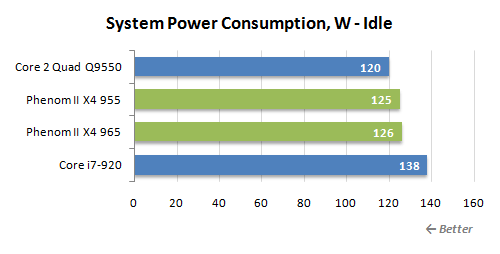
In idle mode when the tested platforms didn’t bear any processor load, things do not look too bad. Phenom II X4 965 power consumption is about the same as the power consumption of the previous Phenom II X4 955 model. Moreover, the AMD Dragon platform show overall better results than the LGA1366, which consumes much more power in idle mode because of higher mainboard and triple-channel memory power needs. But the best result belongs to the old Intel platform with an LGA775 Core 2 Quad processor.
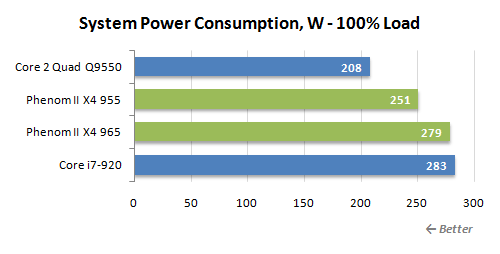
When CPU utilization increases to 100% the general results ratio remains the same. Core i7-920 platform demonstrates the highest power consumption readings. Even though AMD platform started to consume much more power with the new Phenom II X4 965 processor than it used to with Phenom II X4 955, it is still “behind” the LGA1366 system. However, if you are really interested in power system consumption parameter, then you should forget about mainstream AMD processors: even the regular, not energy-efficient CPUs as Core 2 Quad, offer much better performance per watt ratio. Besides, Intel also offers energy-efficient quad-core solutions from the S-series that boast additionally lowered power consumption and heat dissipation.
To get a better idea of the situation, we performed a separate Phenom II X4 965 power consumption test under heavy load when none of the other system components are taken into account. To be more exact, we measured the consumption along the 12 V power line connected directly to the processor voltage regulator on the mainboard. In other words, this measurement method didn’t take into account the efficiency of the voltage regulator circuitry.
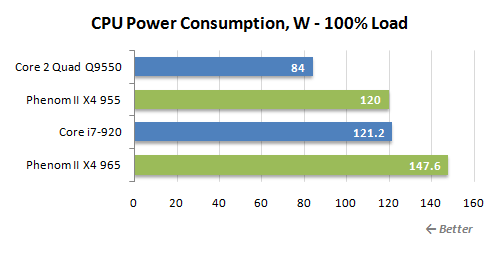
This is where we understand that relatively acceptable readings taken off the AMD Dragon platform are determined mostly by the energy-efficiency of the mainboard chipset. When we measured the actual Phenom II X4 965 CPU power consumption, we got a frightening number that is just a little below 150 W. And it is not just twice as much as a Core 2 Quad processor with comparable performance will consume, but is way higher than the actual power consumption of the Core i7 with 8 virtual cores and not 4. In other words, Phenom II X4 965 has very frustrating power consumption. Even though it is manufactured with 45 nm process, its electrical needs are comparable with those of the top models from the first Phenom generation manufactured with 65 nm technological process.
Overclocking
Another aspect that we absolutely can’t leave out is overclocking. AMD claims that the launch of the new processor coincided with certain progress on the way towards more advanced manufacturing process. Therefore, we can expect overclocking to be pretty successful. We decided to see if it was really so.
Overclocking experiments were performed in the same testbed as was used for performance tests. I would only like to add that the CPU was cooled with Scythe Mugen (Infinity) cooler with Noctua NF-P12.
Since the tested CPU belongs to the Black Edition series, we decided to use simple overclocking techniques: by increasing the multiplier. At the same time, I would like to remind you that the alternative overclocking method based on clock generator frequency increase is just as efficient, which we have seen many times during our previous tests.
Frankly speaking, the results of our overclocking experiments turned out a little disappointing. When we increased the processor Vcore by 0.175 V above the nominal, i.e. to 1.585 V, Phenom II X4 965 remained stable only at 3.8 GHz frequency.
On the other hand, we can’t really expect any serious overclocking improvements. Even specially selected Phenom II X4 TWKR 42 Black Edition overclocking processors can overclock with air cooling only to 4.0 GHz. So, even if we can claim a certain improvement of the overclocking potential, this improvement is extremely insignificant.
Unfortunately, we have to state that the overclocking attractiveness of the top Phenom II X4 processors starts to disappear little by little. At this point AMD has used up almost the entire frequency potential of their 45 nm Deneb cores. With air cooling alone we could only overclock the new Phenom II X4 965 by 10-15%, which is, in fact, another indication that we shouldn’t expect any faster quad-core processors based on Deneb core any time soon.
However, at the same time we have some very good news for overclocking fans. The thermal sensors integrated directly into the CPU cores of the new Phenom II X4 965 processors have finally been calibrated correctly. It means that during work in nominal mode and during overclocking you can finally use not only the readings off the thermal diode beneath the CPU socket, but also the readings off the CPU itself, which are more precise and have considerably lower lag effect.
The screenshot below, for instance, shows the temperature of the Phenom II X4 965 processor working at 3.8 GHz during the LinX run that we use to test the system stability.
I would like to remind you that processor sensors used to report absolutely unreal temperature that was about 20 °C lower than the actual one, which made it impossible to trust their readings. Unfortunately, it took AMD over 6 months to fix this issue, but we hope that we will now see correctly calibrated thermal diodes not only in the top Phenom II X4 processors, but also in other 45 nm CPUs.
AMD Overdrive 3.0
AMD has started to pay special attention to software support of their Dragon platform lately. Targeting the computer enthusiast community, company developers got very involved into improving their brand name Overdrive utility. As we have already pointed out in our previous articles, this utility monitors and manages all the primary parameters of the CPU and memory subsystem. In fact, Overdrive allows users to get easy access to all BIOS Setup settings dealing with system fine tuning and overclocking right from the OS.
Many AMD system owners have had a great opportunity to really enjoy the convenience of the Overdrive utility. It simplifies and accelerates overclocking significantly. It allows users to configure all major processor and memory related settings directly from the OS and they will kick in without any system restarts. As a result, Overdrive is very convenient for initial search for most optimal CPU and memory settings, so that you could transfer them to the mainboard BIOS Setup after a practical test.
The new AMD Overdrive version 3.0.2 that is currently available for download supports a few very interesting features. The first one is BEMP technology (Black Edition Memory Profiles). In fact, this technology may be regarded as some alternative to XMP – optimized settings for DDR3 modules used in Intel platforms. Although AMD’s approach pursues the same goals – to optimize the memory subsystem for specific memory modules – it is still a little different. AMD developers offered to save profiles not in the memory modules SPD, but on their web-server. As a result, once Overdrive utility defines the make and model of your DDR3 SDRAM, it can load and activate memory timings, memory frequency, frequency of the North Bridge part integrated into the CPU and their voltages according to the best recommendations of AMD engineers.
Unfortunately, the list of memory modules supported by this BEMP technology is still pretty limited and it seems to be expanding slowly. Moreover, although AMD promised us that the Mushkin 996601 memory that we used should be supported, we didn’t manage to load any settings profiles for it using Overdrive utility.
The second function that we would like to specifically mention in this chapter of our review is called Smart Profiles. This technology allows to speed up (or even slow down) the CPU cores for certain tasks. Overdrive can determine what applications are active at a given moment of time and depending on that reconfigure the system parameters accordingly. The utility has a certain number of presaved profiles, mostly for popular games (new profiles can be downloaded automatically from the AMD web-server), but you can also configure all parameters manually.
The value of this technology is also in the fact that profile settings allow changing the multipliers for all processor cores independently. Therefore, if some game uses only two processor cores, you can lower the frequency of the other two for the time being, thus saving some power and ensure better overclocking of the active cores, for example.
So, AMD Overdrive offers AMD CPU owners some analogue to Intel Turbo Mode. With some persistence on your end you could increase the efficiency of your system. However, Intel Turbo Mode is autonomous as there is special logic in Core i7 CPUs that controls it. AMD makes the user responsible for managing the interactive adjustment of the CPU clock speed, which limits the functionality of Smart Profiles. Moreover, Smart Profiles technology is fully based on AMD Overdrive, so it won’t work unless you load and activate this utility.
Gaming Performance
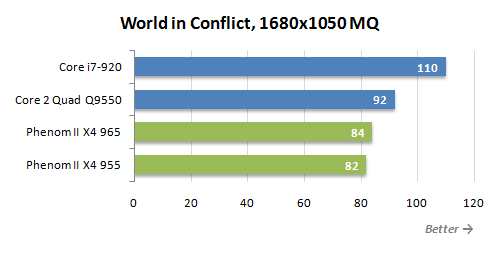
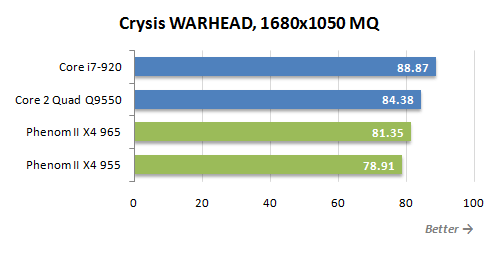
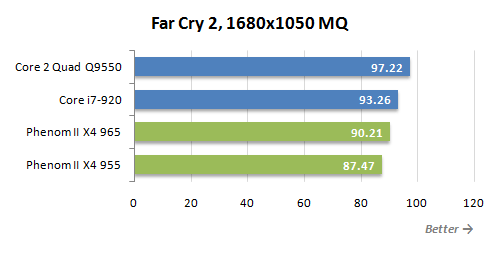
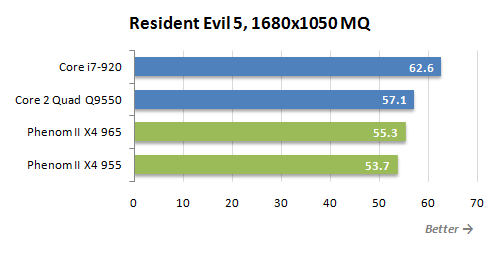
To our regret, Phenom II X4 965 runs worse in gaming applications than in general-purpose tasks. Core 2 Quad Q9550 with a significant amount of L2 cache memory is about 5-6% faster than the new AMD solution. And that is despite the fact that the CPU on Core microarchitecture has 20% lower core frequency! In other words, gaming tests show very clearly that Stars (K10) microarchitecture used by AMD is getting dangerously close to becoming completely obsolete. Moreover the Core i7-920 working at a lower clock frequency is even farther ahead of the new Phenom II X4 965 in contemporary games than Core 2 Quad Q9550. So, it will be extremely hard for AMD to eventually compete against the upcoming Lynnfield processors.
Performance during Video Encoding
Video encoding is the type of work that AMD processors are especially good at. The advantages of Phenom II X4 965 over Core 2 Quad Q9550 is about 15% on average, which is a pretty impressive result. However, even this serious advantage is no problem for the Core i7 CPU supporting Hyper-Threading technology. As a result, Phenom II X4 965 will be able to compete successfully only against those Lynnfield CPUs that will belong to the Core i5-700 series, but not against the Core i7-800 supporting this technology.
Performance in Video Editing Applications
It is quite expected that during video editing the situation is pretty much the same as during video encoding (it is especially true for the indisputable advantage demonstrated by the CPUs with Hyper-Threading support). Some consolation for the AMD fans could be the fact that Phenom II X4 processors do pretty well in Premiere Pro and even outperform the competitor from Core 2 Quad family. However, do not forget that we are comparing the new AMD processor against the previous generation Intel solution that has been in the market for almost two years.
Performance in Image Editing Applications
The new Phenom II X4 965 performance almost as fast as Core 2 Quad Q9550 in the image editing applications, but still is about 4% behind on average. As for the comparison against a more advanced Core i7 CPU, there is not a single chance: just take a look at the diagram and see for yourselves.
Performance during Rendering
Final rendering in 3D modeling suites can be easily split into parallel threads that is why we are not surprised to see Core i7 do so well in the first two tests. Higher clock frequency allows the new Phenom II X4 to compete successfully against Core 2 Quad Q9550, but that’s about it. However, when we get to AutoCAD application, Phenom II X4 965 does more than good: it is not just 30% faster than Core 2 Quad of the similar price but even outperforms a more expensive and more technologically advanced Core i7 CPU.
Performance during Scientific Calculations
Once again we have to state that Phenom II X4 965 is not only a little behind Core i7-920, but also falls behind Core 2 Quad Q9550. So, even though the speed of Phenom II X4 processors increased by 400 MHz over the past year and reached its maximum (for the time being), AMD still didn’t manage to offer a successful alternative even to Core 2 Quad family. As we see, the top Phenom II X4 can barely compete against the middle solution from the previous generation Intel lineup.
Conclusion
Phenom II X4 965 processor launch is hardly an unexpected event. Once AMD got the new 45 nm Deneb core at their disposal that featured much more impressive frequency potential than the previous Agena core, they started pushing its frequencies higher and higher in an attempt to catch up with Core 2 Quad and Core i7 that have gone far ahead by then. And today the clock speed of Phenom II X4 processor family has reached 3.4 GHz, which is higher than any of the contemporary Intel processors can boast.
But unfortunately, this high clock speed revealed all the drawbacks of Stars (K10) microarchitecture that AMD have been using in their processors for the last 2 years. As we have seen during our tests, the new Phenom II X4 965 working at 3.4 GHz frequency is pretty much as fast as Core 2 Quad Q9550 at 2.83 GHz nominal speed and fall behind Core i7-920 with even lower nominal frequency of 2.66 GHz. So, AMD CPUs lose to Intel competitors quite significantly in IPC (instructions per clock). It is this particular fact, but not the insufficiently high clock speeds, that do not allow AMD solutions to find their way into the high-end price segments.
Moreover, considering that Phenom II X4 965 has increased to 140 W typical heat dissipation, its launch seems even more to be the “last resort”. We obviously shouldn’t expect Phenom II X4 processor family to speed up any further, at least until new Deneb core stepping comes out (which we have no information of so far). So, Phenom II X4 965 will most likely remain the fastest quad-core AMD processor for a while. And within this period of time Intel may not only expand their Lynnfield processor family, but also start production of 32 nm technologies. In other words, while today we reviewed Phenom II X4 965 as a mainstream solution, in the near future Phenom II X4 processor family will have be just a low-cost quad-core offering, like first generation Phenom X4 CPUs.
Even today the position of the new Phenom II X4 965 Black Edition processor is pretty vague. The official price of the new Phenom II X4 965 is set at $245 and the users (mostly in the North American market) were promised additional discounts when purchasing a bundle including a CPU and a mainboard, so looks like our hero could become a pretty good choice for AMD fans. However, it still has a few very serious drawbacks, such as high power consumption and lower performance during overclocking can scare away some of the potential Phenom II X4 965 owners. Therefore, we believe that it can be of interest only to those users who already have a Socket AM2+ or Socket AM3 platform and would like to increase their computational potential by upgrading the CPU. Frankly speaking, we can’t tell you what about the new Phenom II X4 965 Black Edition processor could possibly attract new fans.